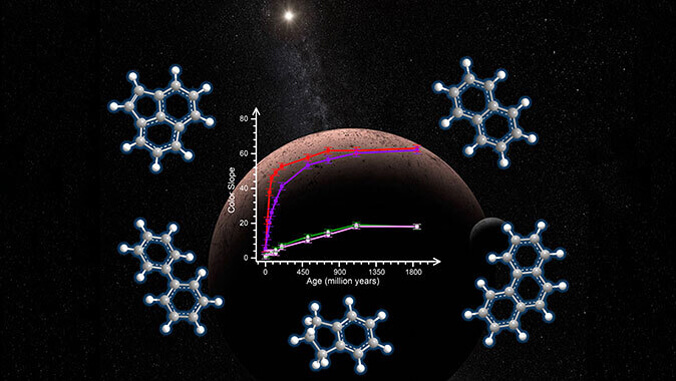Colorful Kuiper Belt Puzzle Solved By UH Researchers
The Kuiper Belt is a massive disk of icy bodies, including Pluto, that is located just outside of Neptune’s orbit in our solar system.
 Aromatic structures linked through unsaturated hydrocarbon chains drive the color variety of hydrocarbon rich surfaces of Kuiper Belt objects. Objects observed in the Kuiper Belt exhibit a unique color range than any other solar system population ranging from white to dark reddish. While the source of this diversity in colors is unknown, scientists have speculated that it is likely the result of the prolonged exposure to radiation of organic materials by galactic cosmic rays.
Aromatic structures linked through unsaturated hydrocarbon chains drive the color variety of hydrocarbon rich surfaces of Kuiper Belt objects. Objects observed in the Kuiper Belt exhibit a unique color range than any other solar system population ranging from white to dark reddish. While the source of this diversity in colors is unknown, scientists have speculated that it is likely the result of the prolonged exposure to radiation of organic materials by galactic cosmic rays.
A new study led by researchers in University of Hawaiʻi at Mānoa’s Department of Chemistry has replicated the environment in the Kuiper Belt to discover what is causing the array of colors in hydrocarbon-rich surfaces of Kuiper Belt objects, providing a solution to a long-standing problem in astrophysics. The study was published in Science Advances on May 31.
The research team led by Professor Ralf I. Kaiser performed the cutting-edge research at UH Mānoa. They used ultrahigh vacuum irradiation experiments and conducted comprehensive analyses to examine the color evolution and their source on the molecular level as galactic cosmic rays processed hydrocarbons, such as methane and acetylene, under Kuiper Belt-like conditions.
Aromatic (organic molecules with fused benzene rings) structural units carrying up to three rings, for example in chemical compounds phenanthrene, phenalene and acenaphthylene, connected by hydrogen-deficient bridges among each other were found to play a key role in producing reddish colors. The UH experiments demonstrated the level of molecular complexity of galactic cosmic rays processing hydrocarbons and provided insight into the role played by ices exposed to radiation in the early production of biological precursor molecules, a molecule that participates in a chemical reaction that produces another molecule.
“This research is a critical first step to systematically unravel the carriers of the molecular units responsible for hydrocarbon-rich surfaces of Kuiper Belt objects,” Kaiser said. “Since astronomical detections also detected, e.g., ammonia, water, and methanol, on the surfaces of Kuiper Belt objects, further experiments on the cosmic ray processing of these ices hopefully reveal the nature of the true color diversity of Kuiper Belt objects on the molecular level.”
The research team consisted of Ralf I. Kaiser, Chaojiang Zhang, Cheng Zhu, Andrew M. Turner and Ivan O. Antonov from UH Mānoa; Adrien D. Garcia and Cornelia Meinert from Côte d’Azur University in France; Leslie A. Young from the Southwest Research Institute in Colorado; and David C. Jewitt from UCLA, who previously worked at UH’s Institute for Astronomy.
Publication: Chaojiang Zhang, et al. Processing of methane and acetylene ices by galactic cosmic rays and implications to the color diversity of Kuiper Belt objects. Science Advances, (2023). DOI: 10.1126/sciadv.adg6936
Original Story Source: University of Hawaii at Manoa

 Alerts Sign-up
Alerts Sign-up